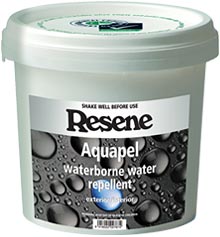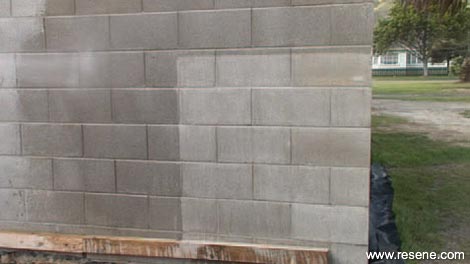Resene DIY project #5
How to paint like a professional - training videos and project sheets
Applying Resene Aquapel water repellent to concrete blocks
Resene Aquapel (see Data Sheet D65) is a waterborne water repellent developed to improve the water resistance of cementitious surfaces, including concrete block, brickwork, plaster and fibre cement, concrete and terracotta.
| View video |

When applied according to instructions water will bead and run off the Resene Aquapel finished surface reducing water ingress and resisting dampness. As a result moss and mould are less likely to take hold and the surface will remain cleaner and less blemished than uncoated areas.
Resene Aquapel is easily applied and effectively repels water from the concrete surfaces including concrete blocks, however it will not weatherproof porous blockwork from wind driven rain. Resene recommends the use of Resene X-200 weathertight membrane for this purpose. Refer to Project sheet #2 for Resene X-200 (see Data Sheet D62).
Resene Aquapel is available in two variants, waterborne and solventborne, with the waterborne product recommended for most situations except when used under exterior clear finishes, such as Resene Uracryl and Resene Uracryl GraffitiShield or on highly polished concrete (including GRC, glass reinforced concrete).

Resene Aquapel is a waterborne water repellent developed to improve the water resistance of cementitious surfaces.

Resene X-200 is recommended for the weatherproofing of porous blockwork from wind driven rain. Refer to Project sheet #2.
The video and project sheet refer to applying Resene Aquapel waterborne, however the spreading rates and general application techniques apply to both variants.
When applying Resene Aquapel it is important to apply sufficient material to effectively repel water. This will vary greatly depending on the porosity of the substrate.
The table shows typical spreading rates:
| Substrate | Spreading rate |
|---|---|
| Concrete block | 2.5m2 per litre |
| Tilt slab concrete | 11m2 per litre |
| Precast concrete | 11m2 per litre |
| Plaster | 5-6m2 per litre |
The degree that water is repelled is directly proportional to the amount of Resene Aquapel applied to each square metre.
We strongly recommend calculating the amount required based on the table above before purchasing the exact volume required and ensuring it is applied at the specified volumes.
Resene Technical staff can advise if required.
For new areas ensure the surface is clean and dry, and surface contaminants removed. For uncoated areas kill any moss and mould using Resene Moss & Mould Killer before waterblasting or scrubbing clean to remove moss and mould residue and other contaminants.
Stir well using a flat bladed stirrer.
Resene Aquapel is easily applied using a common garden sprayer. It can also be applied using a brush and for large areas, an airless spray. Use a funnel and clean can as a ladle.

We are demonstrating the application on one square metre of new concrete block. We expect to use 2.5 litres per square metre, noting that concrete blocks are very porous.
Apply the product in a consistent even manner, working from the bottom up as in this case or top down. Pay particular attention to the concrete block pointing.

To ensure the surface is completely saturated, three wet on wet applications are undertaken.
Resene Aquapel is readily absorbed into the surface. Less Resene Aquapel will be used on less porous substrates and only one or two passes needed.
Resene Aquapel will take approximately two hours to dry and if used as part of a system can be overcoated after 24 hours.
Resene Aquapel waterborne is not recommended as a first coat under Resene Uracryl or Resene Uracryl GraffitiShield, nor on polished or very smooth tilt slab concrete. Resene recommend the use of the Resene Aquapel solventborne in these circumstances.
Resene Aquapel will continue to repel water for upwards of 10 years, even though there may be no obvious ‘water beading’, depending on exposure and can be reapplied or overcoated.
› Download this project sheet as a PDF
Training Videos and Project Sheets
Learn how to prepare surfaces and apply paint to get the best from your paint finish with these handy videos and project sheets.